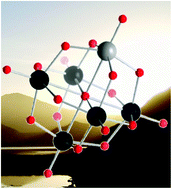Photocatalytic reactivity tuning by heterometal and addenda metal variation in Lindqvist polyoxometalates†
Abstract
A systematic study into the effects of metal substitution on the visible-light photocatalytic activity of prototype metal oxide cluster anions is presented. Four isostructural Lindqvist clusters [VxM6−xO19](2+x)− (M = W, Mo, x = 1, 2) with photooxidative activity in the visible range are reported. It is shown that the photooxidative performance correlates with the number of vanadium atoms in the cluster. Further, two divergent reaction mechanisms are observed depending on the type of addenda metal (i.e. Mo or W) used. When comparing the reactivity under aerated vs. de-aerated conditions, it was found that molybdate-based clusters show significantly increased reaction rates in the absence of oxygen; in contrast, marginally reduced reaction rates were observed for the tungstate-based species under de-aerated conditions. Wavelength-dependent quantum efficiency studies provide insight into the visible-light reactivity of all four species. Radical scavenging experiments suggest that the photocatalysis proceeds via formation of hydroxyl radicals. Cluster recycling studies demonstrate the robust nature of the homogeneous photocatalysts.


 Please wait while we load your content...
Please wait while we load your content...